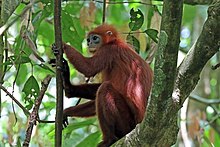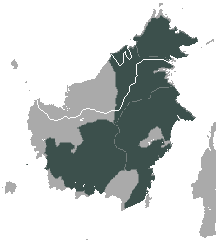Maroon leaf monkey
| Maroon leaf monkey[1] | |
|---|---|

| |
| Gomantong, Borneo | |
| Scientific classification | |
| Kingdom: | Animalia |
| Phylum: | Chordata |
| Class: | Mammalia |
| Order: | Primates |
| Suborder: | Haplorhini |
| Infraorder: | Simiiformes |
| Family: | Cercopithecidae |
| Genus: | Presbytis |
| Species: | P. rubicunda
|
| Binomial name | |
| Presbytis rubicunda (Müller, 1838)
| |

| |
| Maroon leaf monkey range | |
The maroon langur, maroon leaf monkey, or red leaf monkey (Presbytis rubicunda) is a member of the family Cercopithecidae. It is found on the southeast Asian island of Borneo and the nearby smaller Karimata. P. rubicunda mostly live in forests at altitudes below 2,000 m. They feed on leaves (36%), .[2]
Ecology[]
Distribution and Habitat[]
Red leaf monkeys (Presbytis rubicunda) are found in Southeast Asia. Red Leaf monkeys are endemic to the island of Borneo. Their habitat is dense and has dipterocarp evergreens.[3]
Borneo has a healthy tropical rainforest. It also contains shallow swampy areas made up of acidic, decomposed plant matter. These swampy areas have seasonal bouts of dry weather; during the wet season the rivers rise around 2 meters.[3]
Red leaf monkeys are arboreal primates and spend most of their time in the canopy.[4] They also have a large home ranges and low population densities compared to other primates. This is believed to be because they rely on specific trees which are rare and widely dispersed.[3]
Diet[]
Red leaf monkeys are herbivores. Their main diet is fruits, seeds, young leaves, and flowers. They are selective feeders, as food becomes limited they will feed on certain types of plant matter or seeds during their time of abundance. To maintain a balance in their diet, Red Leaf monkeys will consume topsoil from termite mounds.[5]
Their primary food is the young parts of leaves, feeding less frequently on seeds and whole fruits, and occasionally on flowers. Feeding patterns vary seasonally. As the fruit season peaks during June to September, there is an increase of fruit being produced. During this time of abundance, Red Leaf monkeys feed on large amounts of seeds and fruits. Consumption of young leaves happens primarily from October to June; especially in June. During this dry time of the year, Red Leaf monkeys consume more succulent foliage and are decrease their intake of seeds. Flowers are mostly consumed between March and May. There is only one type of flower that becomes a high demand of resource during the month of December. Food becomes scarce during the rainy season, and at this time of year Red Leaf monkeys will feed on mature leaves.[5]
During April, June, and August, are the months when the Red Leaf monkeys consumed top soil of termite mounds. As they ate the termite mounds, they left the termites alone and only ate that of the dirt. This is the way for Red Leaf monkeys to obtain the minerals needed for a balance diet. The termite mound soil has high levels of calcium and magnesium. This soil is very acidic and has a dominant exchanging of cations, due to the aluminium that has been highly leached. Eating of the soil, they are maintaining the balance of minerals by also having a source of potassium and phosphorus. The reason they may be eating termite mounds rather than the soil around the bed of the forest, is because of the construction of the soil due to the termite's saliva. Termite soil has higher nutrient content than that of the bed soil. This foraging mechanism helps them obtain the scarce nutrients and have a balance diet of plant matter and minerals.[5]
Physiology[]
Because the Red Leaf monkeys are from Southeast Asia, this means they must endure the scarcity of fruit due to the unpredictable time period of the releasing fruits.[6] Red Leaf monkeys spends around half their time eating that of leafy greens and the other half in eating seeds and fruits. They favor the digestibility that is high within leaves, which has a fiber level that is relatively low. They combine young leaves with flowers to incorporate protein in high levels. Fruits and seeds allows them to have a concentration that contains high levels of fats or carbohydrates, that is to be stored. The Red Leaf monkeys only eat from rare trees as well as lianas.[3] They must rely on fallback resources during the time that involves the lack of food intake. A 25-month (May to October) observation was conducted, G. Hanya and H. Bernard observed their behavior and surveyed their phenology and vegetation, as well as conducting a chemical analysis which compared leaves that were eaten with the nonfood leaves. During this time, they observed the Red Leaf Monkeys "spending 46 percent of their feeding time on young leaves, 38 percent on seeds, 12 percent on whole fruits, 2.0 percent on flowers, 1.0 percent on bark, and 1.2 percent on pith."[6]
The forest they are located is within the Danum Valley of eastern Sabah, northern Borneo, had rainfall of 3115 millimeter between the year 2007 and 2008. The temperature of this year had a range of 31.4 °C being the maximum, 22.5 °C with the minimum, and the mean being that of almost 27 °C. With their chemical analysis, they had sampled the leaves of having 20 different species being in abundance. But only seven of those species were actually being consumed, leaving the rest (16) not having been consumed. During the time between April and October 2007, there was an increase of the percentage in fruiting trees. Whereas, the year of 2008 had a significant drop of the percentage of fruiting trees due to the lack of water consumption. With this change of climate, the Red Leaf monkey had to rely on the fallback resources to sustain them.[6]
When the time produced a high amount of seeds and fruits, they spent most of their feeding time eating that of what they desired. Due to the lack of water intake of the fruits, they are unable to produce those that the Red Leaf monkey enjoys to eat and they must fallback on what is available. During the time that they must fallback on the resources, they would feed on young leaves that are from a flowering plant known as Spatholobus macropterus. This species of plants are very important to their diet. It has had the total feeding time of 27.6 percent. The leaves that had been consumed had more protein than those that were not consumed. Red Leaf monkeys would feed on different types of leaves due to their abundance. This selection of containing fallback foods of leaves, was in an appearance of the fact that they were trying to obtain both nutrition as well as abundance.[6] When there is an increase of availability of fruits, Red Leaf monkeys expands the time of feeding on seeds by 18 times. As the availability of fruit increases, Red Leaf monkeys' time of feeding raises around 28 percent. With this increase of availability, they eat more species and plants. The seeds within the fruits and plants then become consumed as they feed on these different species of plants and fruits.[7]
References[]
- ^ Groves, C. P. (2005). Wilson, D. E.; Reeder, D. M. (eds.). Mammal Species of the World: A Taxonomic and Geographic Reference (3rd ed.). Baltimore: Johns Hopkins University Press. p. 172. ISBN 0-801-88221-4. OCLC 62265494.
- ^ Jump up to: a b Cheyne, S., Ehlers-Smith, D.A., Nijman, V. & Traeholt, C. (2020). "Presbytis rubicunda". IUCN Red List of Threatened Species. 2020: e.T18131A17953935. Retrieved 10 July 2020.CS1 maint: multiple names: authors list (link)
- ^ Jump up to: a b c d Bennett, Elizabeth L.; Davies, A. Glyn; Waterman, Peter G. (1987). "Food selection by two South-east Asian colobine monkeys (Presbytis rubicunda and Presbytis melalophos) in relation to plant chemistry". Biological Journal of the Linnean Society. 34: 33–56. doi:10.1111/j.1095-8312.1988.tb01947.x.
- ^ Supriatna, Jatna; Soekara, Endang; Manullang, Barita O. (1986). "Group composition, home range, and diet of the Maroon leaf monkey (Presbytis rubicunda) at Tanjung Puting reserve, Central Kalimantan, Indonesia". Primates. 27 (2): 185–190. doi:10.1007/BF02382597. S2CID 12549086.
- ^ Jump up to: a b c Davies, A. G.; Baillie, I. C. (1988). "Soil-eating by red leaf monkeys (Presbytis rubicunda)in Sabah, Northern Borneo". Biotropica. 20 (Association for Tropical Biology and Conservation): 252–258. doi:10.2307/2388241. JSTOR 2388241.
- ^ Jump up to: a b c d Hanya, Goro; Bernard, Henry (2012). "Fallback Foods of Red Leaf Monkeys (Presbytis rubicunda) in Danum Valley, Borneo" (PDF). Int J Primatol. 33 (2): 322–337. doi:10.1007/s10764-012-9580-9. hdl:2433/154842. S2CID 13904987.
- ^ Hanya, Goro; Bernard, Henry (2013). "Functional response to fruiting seasonality by a primate seed predator, red leaf monkey (Presbytis rubicunda)". Tropical Ecology. 54: 383–395.
| Wikimedia Commons has media related to Presbytis rubicunda. |
- IUCN Red List vulnerable species
- Presbytis
- Mammals of Brunei
- Mammals of Malaysia
- Mammals of Borneo
- Primates of Indonesia
- Mammals described in 1838
- Taxa named by Salomon Müller
- Least concern biota of Asia
- Endemic fauna of Borneo
